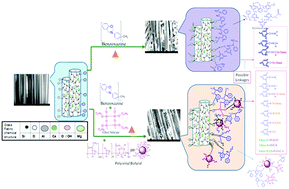Novel glass fabric-reinforced polybenzoxazine–silicate composites with polyvinyl butyral for high service temperature applications
Abstract
The aim of this study is to develop novel glass fabric-reinforced polybenzoxazine–silicate composites with enhanced performances, which can overcome the disadvantages related to the low crosslink density of glass fabric-reinforced polybenzoxazine composites. Glass polybenzoxazine silicate composites were prepared via the copolymerization of bisphenol F benzoxazine using glass fabric, polyvinyl butyral as the coupling agent and various ratios of ethyl silicate. FTIR and DSC were utilized to study the chemical reactions and curing optimization, respectively. It was found that complete polymerization occurred at 200 °C. DMA analysis of the prepared glass polybenzoxazine silicate composites showed enhanced stiffness, crosslink density, service temperature, and network branching with uniform phase distribution. The thermal oxidative decomposition temperatures and char yield obtained by TGA and interfacial adhesion by SEM for glass polybenzoxazine silicate composites were found to be improved when compared to that of the glass polybenzoxazine composites. The composites prepared by this method showed enhanced service temperature, stiffness, crosslink density, thermal oxidative resistance, and char yield when compared to glass fabric-reinforced homopolymerized polybenzoxazine composites. These newly developed glass polybenzoxazine silicate composites are promising materials to overcome various shortcomings associated with polybenzoxazine and other traditional resin composites.



 Please wait while we load your content...
Please wait while we load your content...